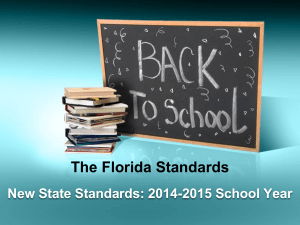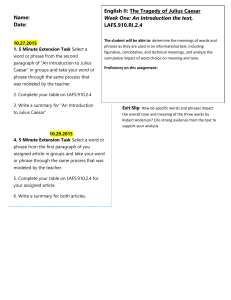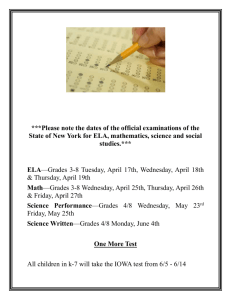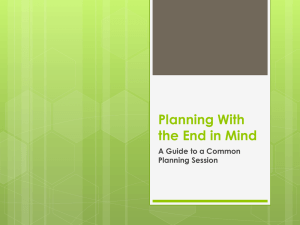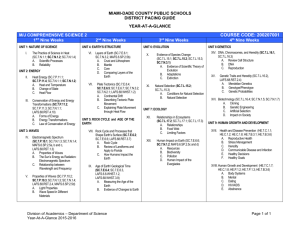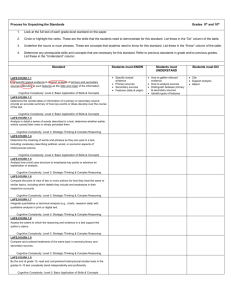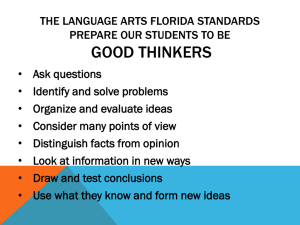ELA Writing Rubric - Grades 4-5 Opinion
advertisement
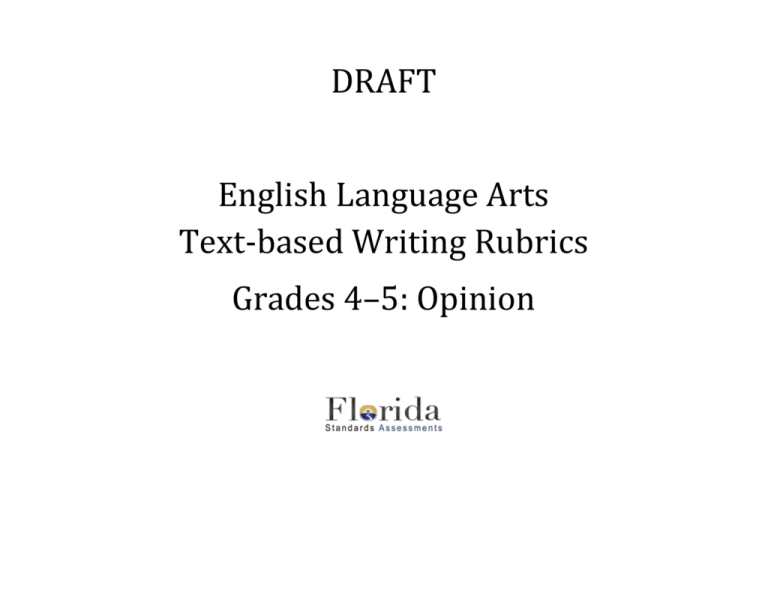
DRAFT English Language Arts Text-based Writing Rubrics Grades 4–5: Opinion DRAFT ELA Text-based Writing Rubrics, Grades 4–5: Opinion Florida Standards Assessments Score Grades 4-5 Opinion Text-based Writing Rubric (Score points within each domain include most of the characteristics below.) Purpose, Focus, and Organization Evidence and Elaboration Conventions of Standard English (4-point Rubric) (4-point Rubric) (2-point Rubric begins at score point 2) 4 The response is fully sustained and consistently focused within the purpose, audience, and task; and it has a clear and effective organizational structure creating coherence and completeness. The response includes most of the following: Clearly stated and strongly maintained opinion with little or no loosely related material Skillful use of a variety of transitional strategies to clarify the relationships between and among ideas Logical progression of ideas from beginning to end with a satisfying introduction and conclusion 3 The response is adequately sustained and generally focused within the purpose, audience, and task; and it has evident organizational structure with a sense of completeness. The response includes most of the following: A maintained opinion, though some loosely related material may be present Adequate use of transitional strategies with some variety to clarify the relationships between and among ideas Adequate progression of ideas from beginning to end with a sufficient introduction and conclusion The response provides thorough and convincing support/evidence for the writer’s opinion that includes the effective use of sources, facts, and details. The response includes most of the following: Relevant evidence integrated smoothly and thoroughly with references to sources Effective use of a variety of elaborative techniques (including but not limited to definitions, quotations, and examples) Clear and effective expression of ideas, using precise language Academic and domain-specific vocabulary clearly appropriate for the audience and purpose Various sentence structures creating language facility The response provides adequate support/evidence for the writer’s opinion that includes the use of sources, facts, and details. The response includes most of the following: Generally integrated evidence from sources, though references may be general, imprecise, or inconsistent Adequate use of some elaborative techniques Adequate expression of ideas, employing a mix of precise and general language Domain-specific vocabulary generally appropriate for the audience and purpose Some variation in sentence structure Continued on the following page 1 July 31, 2014 DRAFT ELA Text-based Writing Rubrics, Grades 4–5: Opinion Florida Standards Assessments Score Purpose, Focus, and Organization (4-point Rubric) Evidence and Elaboration (4-point Rubric) Conventions of Standard English (2-point Rubric) 2 The response is somewhat sustained within the purpose, audience, and task but may include loosely related or extraneous material; and it may have an inconsistent organizational structure. The response may include the following: Partially focused opinion but insufficiently sustained or unclear Inconsistent use of transitional strategies with little variety Uneven progression of ideas from beginning to end and an inadequate introduction or conclusion The response provides uneven, cursory support/evidence for the writer’s opinion that includes partial use of sources, facts, and details. The response may include the following: Weakly integrated evidence from sources and erratic or irrelevant references Repetitive or ineffective use of elaborative techniques Imprecise or simplistic expression of ideas Inappropriate or ineffective domain-specific vocabulary Sentences possibly limited to simple constructions The response demonstrates an adequate command of basic conventions. The response may include the following: Some minor errors in usage but no patterns of errors Adequate use of punctuation, capitalization, sentence formation, and spelling The response is related to the topic but may demonstrate little or no awareness of the purpose, audience, and task; and it may have little or no discernible organizational structure. The response may include the following: Absent, confusing, or ambiguous opinion Frequent extraneous ideas impeding understanding Few or no transitional strategies Too brief to demonstrate knowledge of focus or organization The response provides minimal support/evidence for the writer’s opinion, including little if any use of sources, facts, and details. The response may include the following: Minimal, absent, erroneous, or irrelevant evidence from the source material Expression of ideas that is vague, unclear, or confusing Limited or inappropriate language or domain-specific vocabulary Sentences limited to simple constructions The response demonstrates a partial command of basic conventions. The response may include the following: Various errors in usage Inconsistent use of correct punctuation, capitalization, sentence formation, and spelling 1 0 2 The response demonstrates a lack of command of conventions, with frequent and severe errors often obscuring meaning. July 31, 2014 DRAFT ELA Text-based Writing Rubrics, Grades 4–5: Opinion Florida Standards Assessments Text-based Writing Stimulus and Prompt Guidelines Writing Prompt Specifications Overall Task Description Students will read a stimulus about a single topic. A stimulus consists of several texts written on a single topic. The stimulus should consist of informational or literary fiction or nonfiction texts and can cover a wide array of topics. After reading the stimulus, the students will respond to a writing prompt in which they will provide information on a topic or take a stance to support an opinion or argument. Stimulus Attributes The complexity of the texts used as stimuli should be accessible for the applicable grade. While this is primarily a writing test, a grade-appropriate level of literacy is required. In choosing the text(s), qualitative and quantitative dimensions of text complexity must be balanced by the task considerations required of the reader. Graphics such as infographics, photographs, tables, and diagrams can be included with the stimuli. The graphics used, however, must be purposeful to the task and should supplement the student’s understanding of the topic. During the text review process, Florida educators use professional judgment and experience to determine whether the reading level of each selection is suitable for the grade level. The stimuli for the informative/explanatory prompts should maintain a clear topical connection but may address diverse concepts and ideas. Stimuli for the opinion/argumentative prompts should present opposing points of view. Each point of view should be equally represented so that a student can take either side of a position. Thorough and convincing support for the controlling ideas must be evident in all stimuli. Texts used as stimuli should be interesting and appealing to students at the grades for which the selections are intended. They should be conceptually appropriate and relevant and should reflect realworld settings and events that are interesting to students and are not limited to classroom or schoolrelated situations. Texts with controversial or offensive content should not be included. Confusing or emotionally charged subjects should also be avoided. References to trademarks, commercial products, and brand names should be checked by the contractor’s legal department for permission to use. If there is any question about the accuracy of content, the Florida Department of Education may require at least two additional sources to verify the information in the text. The stimulus will consist of two to four texts. The approximate combined word count of the text sets is listed in the table below. Grade Level 4 5 Minimum Word Count 800 800 Maximum Word Count 1300 1300 The stimulus will be presented along with a writing prompt that asks students to write an essay about the topic. The students will be required to synthesize information from the text sets and must cite specific evidence from the texts to support their ideas. 3 July 31, 2014 DRAFT ELA Text-based Writing Rubrics, Grades 4–5: Opinion Florida Standards Assessments Text-based Writing Stimulus and Prompt Guidelines For the informative/explanatory writing prompts, students will be required to synthesize and analyze ideas from the stimuli to develop and support a controlling idea. For the opinion/argumentative writing prompts, students will be required to synthesize and analyze ideas and evidence from stimuli. They will use these ideas to present and support an opinion (grades 4‒ 5) or to argue and support a claim (grades 6‒11). Assessed Standards The Florida Standards Writing Assessment will assess the following standards from the appropriate grades: LAFS.W.1.1 or LAFS.W.1.2 LAFS.W.2.4 LAFS.W.2.5 LAFS.W.2.6 LAFS.W.3.8 LAFS.W.3.9 4 LAFS.L.1.1 LAFS.L.1.2 LAFS.L.2.3 LAFS.L.3.4 LAFS.L.3.5 LAFS.L.3.6 July 31, 2014 DRAFT ELA Text-based Writing Rubrics, Grades 4–5: Opinion Florida Standards Assessments Text-based Writing Stimulus and Prompt Guidelines Directions Template Grade 4-5 Write an informative essay about . . . . Use information from the passages in your essay. -ORWrite an essay in which you give your opinion about . . . . Use information from the passages in your essay. Manage your time carefully so that you can read the passages; plan your response; write your response; and revise and edit your response. Write (type) your essay in the space provided. You have 5 minutes to read the passages, and plan, write, revise, and edit your essay. July 31, 2014 DRAFT ELA Text-based Writing Rubrics, Grades 4–5: Opinion Florida Standards Assessments Text-based Writing Stimulus and Prompt Guidelines Acceptable Text Types Informational Text Primary Sources/Nonfiction Historical documents (e.g., Bill of Rights) Essays (e.g., informational, persuasive, analytical, historical, scientific) Letters, journals, diaries Secondary Sources/Nonfiction Magazine articles Newspaper articles Editorials Encyclopedia articles Functional Materials Consumer documents (e.g., warranties, manuals, contracts, applications) Embedded in text (e.g., tables, charts, maps, graphs, illustrations, photographs, captions, text boxes) How-to articles Brochures, fliers Schedules Website pages 6 Literary Text Literary Nonfiction Biographical and autobiographical sketches Diaries, memoirs, journals, letters Essays (e.g., personal and classical narratives) Critiques Literary Fiction Short stories Poetry Historical fiction Fables Folk tales, tall tales Legends Myths Drama Fantasy Excerpts from longer works July 31, 2014 DRAFT ELA Text-based Writing Rubrics, Grades 4–5: Opinion Florida Standards Assessments Text-based Writing Stimulus and Prompt Guidelines Possible Topics Essential Skills Literacy Communication Teamwork Leadership Social Studies U.S. History Civics and Government Geography Economics Science, Technology, Engineering, and Mathematics Earth/Space Science Life Science Physical Science Concepts of Technology Computer Technology Information Technology Technology Processes Concepts of Engineering Engineering Tools Engineering Design and Testing Mathematics World Languages Cultural Perspectives Cultural Comparisons Cultural Communities Arts Dance Music Theater Visual Arts Interests Adventure Animals Careers Entertainment Family Friendship Hobbies/Crafts Humor Mystery School Sports/Games Trips/Journey Health and Physical Education Movement Competency Cognitive Abilities Lifetime Fitness Personal Health Health Care Business Management and Administration Finance Financial Literacy Business Plans Marketing Entrepreneurship Transportation of Goods Manufacturing Agriculture Hospitality Industry Tourism Industry 7 July 31, 2014
